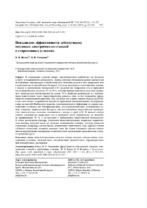| dc.contributor.author | Янчук, В. В. | |
| dc.contributor.author | Романюк, В. Н. | |
| dc.coverage.spatial | Минск | ru |
| dc.date.accessioned | 2022-12-07T13:19:19Z | |
| dc.date.available | 2022-12-07T13:19:19Z | |
| dc.date.issued | 2022 | |
| dc.identifier.citation | Янчук, В. В. Повышение эффективности действующих тепловых электрических станций в современных условиях = Operating Thermal Power Plants Efficiency Improvement under Current Conditions / В. В. Янчук, В. Н. Романюк // Известия высших учебных заведений и энергетических объединений СНГ. Энергетика. – 2022. – № 6. – С. 511-523. | ru |
| dc.identifier.uri | https://rep.bntu.by/handle/data/123341 | |
| dc.description.abstract | В современных условиях вопрос энергосбережения приобретает все большую
остроту и перманентную актуальность. Данная ситуация обусловлена резким скачком цен
на первичные энергоресурсы и необходимостью снижения удельного веса природного газа
в приходной части энергобаланса Беларуси. Согласно имеющимся статистическим данным,
с вводом в эксплуатацию Белорусской АЭС удельный вес природного газа в приходной
части энергобаланса снизится с 97 до 59 %. В хозяйственном комплексе доля этого первичного энергоресурса прогнозируется на уровне 70 %. Наиболее рационально и с наименьшими инвестициями задача энергосбережения решается лишь за счет повышения эффективности использования природного газа, тем более что в связи с вводом Белорусской АЭС
остро стоит вопрос сохранения возможности применения централизованных теплофикационных мощностей. Необходимо повысить термодинамическую эффективность циклов паротурбинных установок, как теплофикационных, так и конденсационных, составляющих основу генерации энергосистемы Беларуси, для восстановления энергетических характеристик энергосистемы, несколько снизившихся с вводом в строй АЭС. В пределе следует
снизить удельный вес природного газа в приходной части энергобаланса до значений,
не превышающих 50 %, в соответствии с требованиями энергетической безопасности.
В статье рассмотрены примеры утилизации низкотемпературных вторичных энергетических потоков, имеющих место на тепловых электрических станциях: теплоты процессов
охлаждения генератора, систем смазки, конденсации отработанного пара турбины и более
глубокого охлаждения уходящих дымовых газов. На основе указанного анализа определяются перспективные направления соответствующих исследований применительно к энергосистеме Беларуси. | |
| dc.language.iso | ru | ru |
| dc.publisher | БНТУ | ru |
| dc.title | Повышение эффективности действующих тепловых электрических станций в современных условиях | ru |
| dc.title.alternative | Operating Thermal Power Plants Efficiency Improvement under Current Conditions | ru |
| dc.type | Article | ru |
| dc.identifier.doi | 10.21122/1029-7448-2022-65-6-511-523 | |
| local.description.annotation | In the present-day conditions, the issue of energy saving is becoming increasingly acute
and permanently relevant. This situation is caused by rapid growth in prices for primary energy
resources and by the need to reduce the share of natural gas in the incoming part of the energy
balance of Belarus. According to available statistics, with the commissioning of the Belarusian
NPP, the share of natural gas in the incoming part of the energy balance decreases from 97
to 59 %. In the economic complex, the share of this primary energy resource is projected at 70 %.
The problem of energy saving is solved most rationally and with the least investment only by increasing
the efficiency of natural gas use, especially due to the commissioning of the Belarusian
NPP, the issue of preserving the possibility of using centralized heating facilities is acute.
It is necessary to increase the thermodynamic efficiency of the cycles of steam turbine plants, both
heating and condensing, which form the basis of the generation of the Belarusian power system,
in order to restore the energy characteristics of the power system, which have somewhat decreased
with the commissioning of the NPP. In the limit, the share of natural gas in the incoming part
of the energy balance should be reduced to values not exceeding 50 %, in accordance with the
requirements of energy security. The article considers examples of utilization of low-temperature
secondary energy flows occurring at thermal power plants: the heat of the cooling processes of the
generator, lubrication systems, as well as the heat of condensation of turbine exhaust steam and
deeper cooling of flue gases. On the basis of this review, it is expected to identify promising areas
of relevant research in relation to the energy system of Belarus. | |

